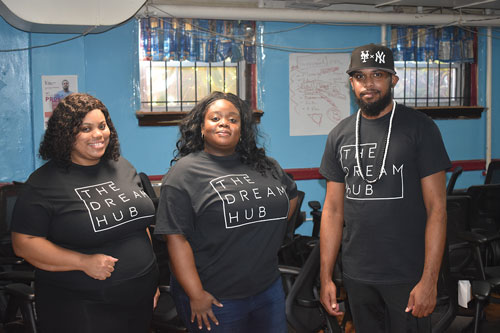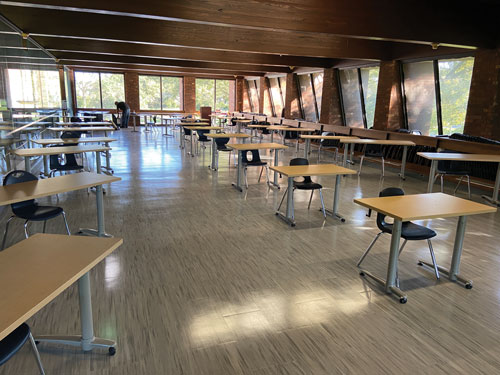Sustainable decommissioning is a system that can be calibrated for all manner of large organizations, ensuring that whatever the future of the workplace holds, the way to get there can benefit the community, the environment and the bottom line.
By Trevor Langdon
The pandemic changed the way we work—and that has changed what our workplaces look like. If your office has not permanently moved into your home, it is likely become more virtual, less obligatory and better ventilated. Employers that are keeping their real estate footprint are reconfiguring it to meet new demands for safety and collaboration.
Unfortunately, this all means more waste. To make room for the office of tomorrow, the office of today is usually sent to landfill. The EPA estimates that 8.5 million tons of office furniture are dumped each year and post-COVID, that number is sure to climb. The environmental cost is obvious, and the financial cost is considerable: just to get rid of all that furniture, companies are spending around $750 million in landfill tipping fees each year.
It is not just that there is a better way; there is also a better system that can eliminate landfill use, meet ESG standards, give back to the community and empower employees. When done right, sustainable decommissioning blends donation, resale, and recycling to keep offices working for everyone. Here are how those three processes can be deployed for maximum effect.
#1: Reuse Via Donation
To start, a sustainable decommission requires each individual piece of office furniture and equipment to be evaluated and allocated according to its condition. Lightly used chairs, desks, tables, and cabinets may still have years of use left in them. When this furniture and equipment is reused in offices and common spaces at non-profits, schools, health centers, and other community centers, these groups can allocate their funds and resources on their programming and the people they serve, rather than sourcing new furniture out of their already strained budgets.
Finding local non-profits that can benefit from these resources is a win-win that boosts an organization’s local community ties and their own social responsibility efforts in the process.
#2: Reuse Via Resale
In many cases, the resale value of an office asset is an opportunity for a company to defray the cost of decommissioning while also avoiding a trip to the landfill. With conventional liquidation, about 80 percent of a company’s inventory is sent to landfill with only a small portion of the items being resold. This process provides less than zero value to the company parting with its surplus assets, as the disposal costs can be substantial. In a well-designed sustainable decommission, suitable buyers for each item can be sourced to maximize both the monetary value of the furniture and its potential for meaningful reuse.
#3: Recycling
Our offices are filled with high-quality wood, plastic and metal. Even if the individual pieces of furniture are no longer useful, these components certainly are. A specialized recycler can generate returns on investment, process a variety of items and reintroduce materials back into the manufacturing process.
A functioning office cubicle produces anywhere between 300 to 700 pounds of waste—the majority of which is ferrous metal, wood and plastic. The typical office chair alone contains dozens of different materials and chemicals on its own. Each material presents its own market and its own challenges when recycling, making it necessary to work with strategic partners to determine the best end destination for each item.
The Bottom Line
Right now, businesses and governments around the world are deciding where and how their employees will work. While every organization’s needs are different, all will have to do something with their current offices. Sustainable decommissioning is a system that can be calibrated for all manner of large organizations, ensuring that whatever the future of the workplace holds, the way to get there can benefit the community, the environment and the bottom line. | WA
Case Study: Commitment to Sustainability
The International Rescue Committee (IRC), one of the world’s foremost humanitarian aid organizations, recently renovated their corporate HQ in Manhattan. In doing so, the IRC seized an opportunity to help local non-profits. As part of their sustainability efforts, they worked with Green Standards to donate their old office furniture to charities, schools and worthy organizations across the five boroughs.
“Essential to the IRC’s long-term strategy is our commitment to sustainability and mitigating our impact on the environment was thus a high priority in planning the renovation,” said Billy Lechert, IRC’s Senior Manager, Facility Development and Projects. “Green Standards helps make that possible by providing the means and resources for the IRC to donate, reuse and recycle as much furniture as possible, enabling our organization to grow while keeping our commitment to sustainability and the environment.”

furnish their co-working space for local entrepreneurs. Their vision for the space has come to fruition thanks to the project. Photo courtesy of Jabari Bruce.

In a typical move, about 80 percent of the furniture and equipment ends up in landfill. When the IRC moved, they kept 100 percent out of landfill. Among the beneficiaries of the IRC’s work with Green Standards were the Twenty Thirty Dream Hub, a community workspace in Jamaica, Queens, founded to support local entrepreneurs, and Lawrence Woodmere Academy, a Long Island school that put the tables and chairs to immediate use in their K-12 classrooms.
To date, Green Standards has helped hundreds of organizations divert 85,000 tons of waste from landfills, offset 206,575 metric tons of carbon emissions, and donated more than $32 million in surplus assets to over 5,500 non-profits.
Trevor Langdon is President of Green Standards Ltd. Trevor is an entrepreneur and corporate sustainability advocate with a focus on commercial office waste and environmental reporting. Since 2011, Trevor has contributed to the growth and strategic direction of Green Standards through various roles. He has worked on several of the largest corporate decommission initiatives in recent history—often to the order of millions of square feet and tens of thousands of employees. For more information, e-mail [email protected].
